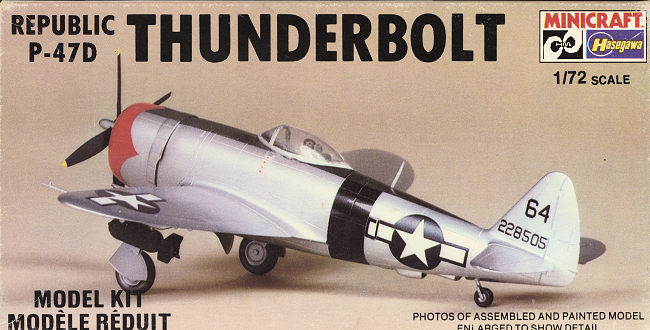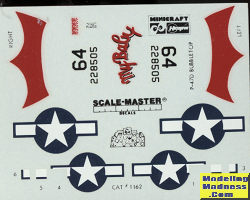
Minicraft/Hasegawa 1/72 P-47D Thunderbolt
|
KIT # |
1162 |
|
PRICE: |
$5.00 on the used kit market |
|
DECALS: |
One aircraft |
|
REVIEWER: |
|
|
NOTES: |
Reboxed Hasegawa kit |

|
HISTORY |
The P-47 was one of those aircraft that was initially not liked by fighter pilots. It was big, it was heavy, and it had really lame climbing performance. It was also not the best dogfighter around. This was especially the way the 4th fighter group felt when it transitioned from its nimble Spitfires to this 'behemoth'.
However, the Thunderbolt had several great qualities. One is that it could dive like no one's business, an attribute that helped many pilots who got into trouble with the enemy to disengage. Another was that it could take a lot of punishment. Thanks to the air cooled radial engine, it wasn't able to be knocked down by a single bullet through a coolant line. This made it perfect for ground attack and it was soon outfitted with wing bomb racks. It was with the tactical air force that the P-47 soon came into its own.
Though the type was continually improved in terms of more powerful engines and broader props to help the climbing situation, it never reached the 'hero' status of the P-51 or for that matter, the Spitfire. The type also soon disappeared rather quickly from the inventory after the war and while it was used by many other nations, simply did not have the longevity of the Mustang.
|
THE KIT |
The gear doors are not separate and need to be cut . There is no real wheel well
detail either, aside from a retraction strut molded into the inside of the upper
wing. The kit comes with a pair of bombs for the molded in wing racks, or you
can use the cylindrical 'paper' drop tanks that were used in Europe. One
thing that has plagued pretty much all the various pressings of this kit are
some sink marks on the wing. This kit has the full ailerons and flaps molded to
the upper wing halves. This makes for some rather thick plastic in the flap
areas. Even the initial pressings had a small sink mark on the underside flap
area, others had some long ones on the upper flap. This one doesn't seem to have
the upper wing sink mark though there is still a fairly long one on the
underside that will need to filled if you are concerned.
 One of the first kits by Hasegawa to embrace the engraved panel line revolution
of the early 1980s, the P-47 kit has held up rather well. Typical of what you
find even today on Hasegawa 1/72 kits, there are decals for the instrument panel
and not much else in the way of detailing for the cockpit section. Sure, there
is a seat and instrument panel, that that is about it. It is very much a
transition kit and really can benefit from a replacement cockpit. Fortunately,
True Details does one at a very reasonable price. The canopy is a single piece,
but clear enough to see the interior fairly well.
One of the first kits by Hasegawa to embrace the engraved panel line revolution
of the early 1980s, the P-47 kit has held up rather well. Typical of what you
find even today on Hasegawa 1/72 kits, there are decals for the instrument panel
and not much else in the way of detailing for the cockpit section. Sure, there
is a seat and instrument panel, that that is about it. It is very much a
transition kit and really can benefit from a replacement cockpit. Fortunately,
True Details does one at a very reasonable price. The canopy is a single piece,
but clear enough to see the interior fairly well. Instructions are basically the same as the
Japanese ones, but all the wording is in English. The kit includes a single set
of decals for an unidentified unit. Based on the black fuselage stripe and the
scalloped cowling, it could be with the 58th Fighter Group, but I am really not
sure. The decal sheet is nicely printed which is a bit unusual for Scalemaster
of the time as they were known for color bleeding into the clear carrier and off
register kit decals. If you use the kit markings, you'll need to match the red
for the forward cowling and paint the black fuselage stripe. There are plenty of
aftermarket for this one.
Instructions are basically the same as the
Japanese ones, but all the wording is in English. The kit includes a single set
of decals for an unidentified unit. Based on the black fuselage stripe and the
scalloped cowling, it could be with the 58th Fighter Group, but I am really not
sure. The decal sheet is nicely printed which is a bit unusual for Scalemaster
of the time as they were known for color bleeding into the clear carrier and off
register kit decals. If you use the kit markings, you'll need to match the red
for the forward cowling and paint the black fuselage stripe. There are plenty of
aftermarket for this one.
|
CONCLUSIONS |
Should you have built this kit nearly 40 years ago, you would find absolutely no difference. Since the kit only provides the pointy Curtiss-Electric prop, you do need to be careful what you pick for aftermarket markings or find the proper prop. You also cannot do the later -30 versions that have the long fin fillet or those retrofitted with it. Otherwise, it should easily prove to be a quick and painless build.
September 2018
Copyright ModelingMadness.com. All rights reserved.
If you would like your product reviewed fairly and fairly quickly, please contact the editor or see other details in the Note to Contributors.